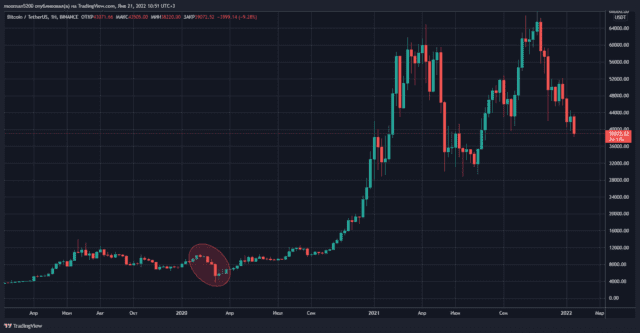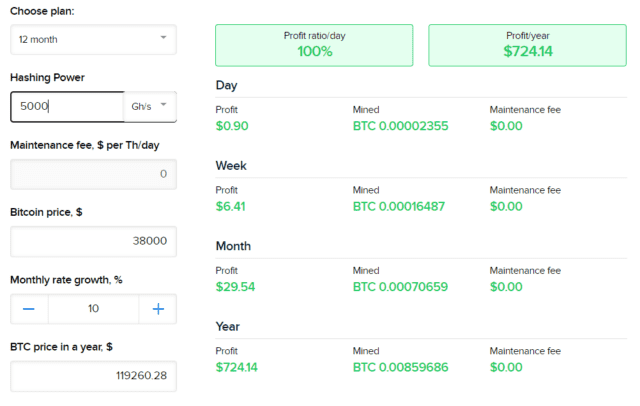Why is investing in cloud mining profitable in 2022?

The beginning of 2022 was not the best for the crypto market. Bitcoin, after hitting another all-time high back in November, has now collapsed by more than 40 percent in just a couple of months. There is panic and uncertainty in the market, and many may think that the time for profitable crypto investing is over. However, that’s not true – even in times of crisis, cryptocurrency can give you a unique opportunity to make money with cloud mining. Today we will learn exactly why Hashmart cloud mining remains a profitable investment even now.
What does the price of Bitcoin depend on?
Bitcoin and the entire crypto market, in general, are closely related to the concept of volatility – a measure of the pace of change in the price of an asset over a certain period of time. That is, the higher the volatility, the faster the BTC price changes. Since its launch in 2009, Bitcoin has always been very volatile, especially compared to traditional assets such as stocks. The fall (correction) of the BTC price in early 2022 is one of the consequences of the cryptocurrency’s high volatility. It has three main reasons.
Supply and demand for Bitcoin
The supply-to-demand ratio is a key factor in shaping the value of almost anything that can be traded in the market. Supply is the amount of the asset freely available for purchase, and demand is the amount of the asset that buyers want to buy.
Unlike traditional assets, the supply of Bitcoin is finite. It is limited to the number of coins already mined to date. That said, some of it is already irretrievably lost or stored for years in the wallets of long-term investors. The demand for BTC, in theory, could be unlimited, because millions of people around the world can buy it. Limited supply and increased demand has been the main reason for Bitcoin’s growth in recent years.
Investor activity
Demand depends directly on investors’ willingness to buy the cryptocurrency, in particular, the biggest market players (they are often also called “whales”). These are now cryptocurrency funds and even large U.S. companies whose shares are traded on the stock market. They hold hundreds of thousands of BTC in their cryptocurrency wallets. Once the whales want to sell a significant portion of their coins, it will increase the available supply of bitcoins on the market. With little demand, such actions usually result in a drop in the price of Bitcoin.
In addition, large investors are a “benchmark” for common traders who, seeing the mood for mass Bitcoin sales, also liquidate their coin holdings. This creates an avalanche effect – the price of the asset will fall until the supply is reduced, that is, until everyone who wants to sell their bitcoins.
Regulation of the crypto market
This issue is relevant specifically for Bitcoin. The main cryptocurrency is a decentralized network maintained by independent miners around the world. Bitcoin users can make transactions of financial value without government interference. This creates a danger of using cryptocurrencies to finance crime and money laundering. Therefore, in recent years, global governments have increasingly focused on controlling the crypto market and limiting ways to profitably buy cryptocurrency without revealing the identity of the buyer.
Often, this control boils down to trivial bans on the activities of crypto investors and miners. In 2021, the Chinese government completely banned Bitcoin mining in China, which caused a mass migration of miners outside the country. China remained the largest center where cryptocurrency mining took place until 2022 because of its relatively low electricity tariffs. The migration of miners and bans on all crypto activity forced many investors to sell their coins. This increased the supply of BTC on the market and led to the aforementioned avalanche effect of Bitcoin’s price drop.
Why is Bitcoin falling in 2022?
The major cryptocurrency reached its all-time high last November, but since then it has fallen in value by more than 40 percent. One of the main reasons is the Federal Reserve’s (Fed) rollback of U.S. economic stimulus. The Fed came to such measures after a rise in dollar inflation caused by the very stimulus that the U.S. economy needed to deal with the aftermath of the COVID-19 pandemic.
On the Bitcoin price chart, its latest collapse may indeed seem “scary” to novice investors.
But here’s a little comparison – the same Bitcoin chart, only in March 2020. The correction here is much stronger and faster.
Let’s zoom in a little bit and see that since the March correction, the price of BTC has increased almost 10 times!
There are a lot of such moments in the history of cryptocurrency. The main lesson to learn from all this is that even after the fall by tens of percent, the price of Bitcoin returns to rapid growth. It’s all due to the very limited supply of BTC. Sooner or later, demand for the cryptocurrency returns to its historical maximum, and it begins to appreciate again. That is why Bitcoin correction is more of a profitable opportunity to enter the market and mine, rather than a reason to panic.
Difficulty and costs for miners
The two main expenditures for miners are electricity and the cost of Bitcoin mining equipment. That said, the profitability of mining depends on the difficulty of the process. The difficulty changes about every two weeks depending on the hashrate – the total processing power of all the miners in the Bitcoin network. That is, the more miners there are, the “harder” it is to mine bitcoins. For example, if the difficulty increases after the next recalculation with the same hardware, the miner will receive fewer bitcoins for finding a new block.
The difficulty often has a high correlation with the price of the cryptocurrency. The logic here is simple: the price of Bitcoin is falling, for some miners mining the cryptocurrency is not profitable and they are forced to leave the market. But for those who managed to optimize their activities and work even after the correction of the cryptocurrency, the profit increases due to the same drop in difficulty. After the next wave of BTC growth, they can sell the accumulated coins at a profit. Ordinary users of the Bitcoin network also benefit in the form of falling transaction fees (in the dollar equivalent). That is, they pay less in the regular currency for Bitcoin transfers.
Often a market correction is associated with the emergence of a huge amount of cheap mining equipment. Those miners, for whom the process has lost profitability, are also forced to liquidate some of their crypto farms to at least somehow compensate for the losses. That is why large mining centers and individual miners can benefit from the current situation by buying cheaper mining equipment. However, this is only true if they have access to a relatively cheap source of electricity.
Cloud mining on Hashmart
If you don’t know how to make money from cryptocurrency drops either, and you don’t have a lot of startup capital to buy your own crypto farm, you can participate in cloud mining. Cloud mining is renting the capacity of a large mining center to its customers. They pay a commission to maintain the equipment, and in return, they receive passive income.
Why is it often unprofitable to mine solo?
The cost of mining equipment is measured in thousands of dollars, while the price of a profitable Bitcoin mining crypto farm can be up to tens of thousands of dollars. With the growth of BTC price, the payback period of such a farm is on average 8-12 months (depending on the cost of electricity). At the same time, individual miners are not protected from the above-mentioned Bitcoin price adjustments, which put the entire business at risk. In other words, by using Hashmart services you protect yourself from a significant amount of risks. At the same time, you still have a reliable source of passive income.
What happens to mining after a market correction?
So, the difficulty of mining is starting to drop, fees are going down, and many miners are being forced out of the market. The situation is not the best, but now we will show you how you can benefit from it. As an example, let’s calculate the profitability of mining on Hashmart for 12 months. To do this, we’ll use the miner calculator on the website.
We enter the desired investment size (here it is measured in hashrate, i.e. the computing power of the equipment you rent from the platform). Let’s take, for example, buying 5000 hashes per second at the current cryptocurrency price of $38 000.
Such an investment would cost us about 40 000 rubles or $520.
The calculator also takes into account the projected average Bitcoin price growth over 1 month. We leave it within 5 percent – it’s a pretty realistic scenario, under which BTC will grow to $68 242 by the end of the year (around the historical record value at most).
The calculation results are $526.34 in net profit from a cloud mining investment. That is, this source of passive income will give you profitability of 100 percent in just one year! Even by the standards of the crypto industry, this is a very good investment, especially when you don’t have to do it all the time.
Let’s try to make a similar calculation again, but only with an average monthly growth rate of BTC at 10 percent. With this prediction, our income for the year will be more than $725.
As we can see, the lower the Bitcoin price falls, the more hidden opportunities appear, where to invest in 2022. Such an investor is not exposed to the regular risks of conventional mining, but can still enjoy all its benefits.
Conclusion
What happens if the price of Bitcoin does not rise by the end of the year? This scenario is also possible. But it doesn’t mean that you will be left at a loss after investing in Hashmart. As a reminder, our platform pays daily income to users from cloud mining in cryptocurrency, i.e. bitcoins. The bottom line is that you can simply accumulate the coins you get without selling them every month.
Let’s say the value of BTC has risen by more than 10 percent in a month. This is a profitable opportunity to sell Bitcoin mined on Hashmart. The next month, the cryptocurrency drops in value, so you decide to hold off selling for now. In another month, Bitcoin rises again – you can liquidate your cryptocurrency holdings on the exchange already during this period.
Remember, Bitcoin has been a volatile asset since its inception. Corrections, ups, and downs are common in the crypto market. And each of these periods is of great interest to investors because high volatility can lead to good profits. While Bitcoin is “recovering” after another collapse, take advantage of this opportunity, read reviews of cloud mining on our website and make your first investment in Hashmart!










